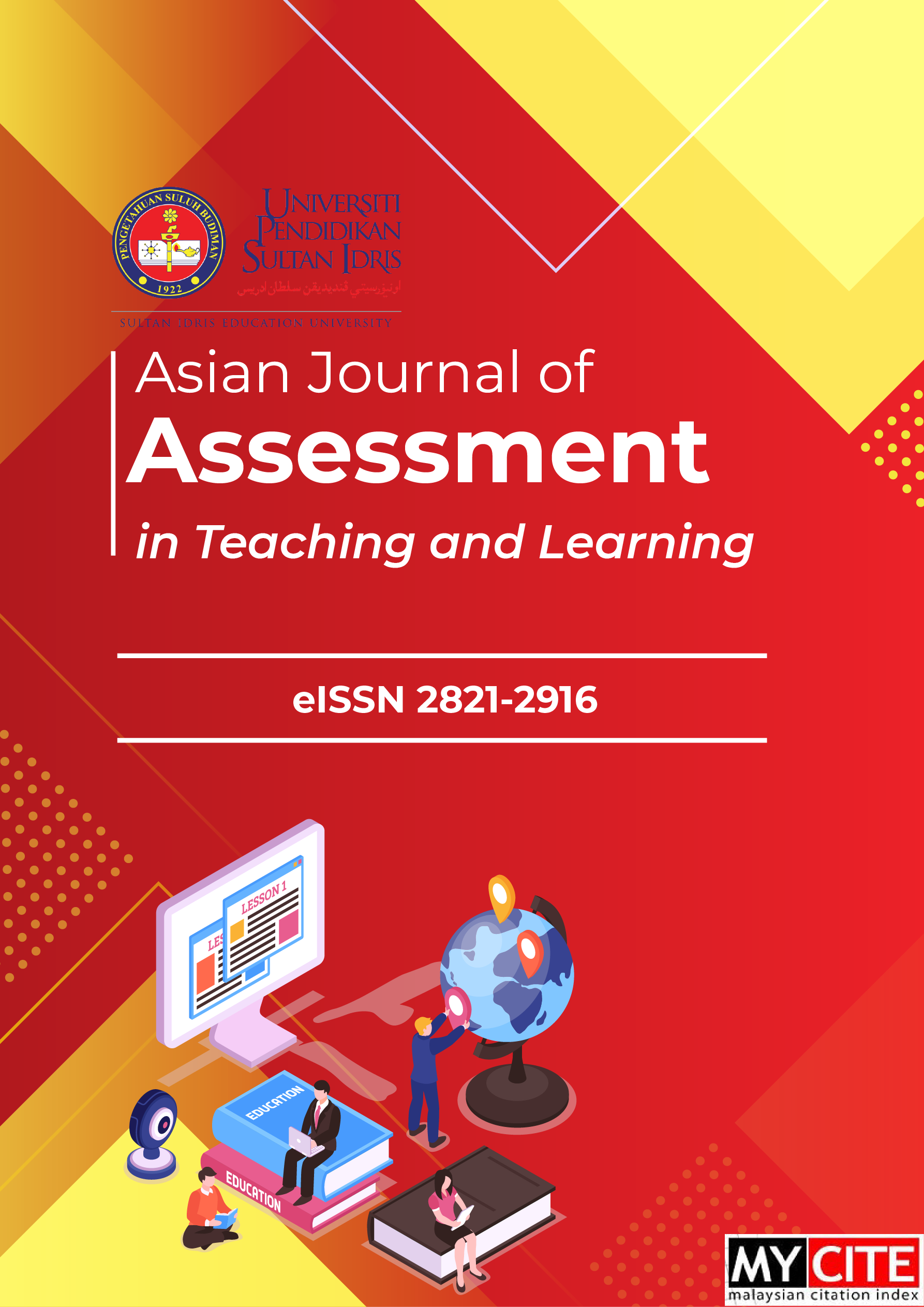Analysis of Students Performance in Mathematics before and during Covid-19 Pandemic using PageRank: A Preliminary Study
DOI:
https://doi.org/10.37134/ajatel.vol12.2.9.2022Keywords:
PageRank, Directed Graph, Mathematics Performance, RankingAbstract
In a normal situation, a university is constantly utilizing standard statistical analysis tools to provide a student's ranking through their academic achievement. The tools provides analysis of pairwise comparison among students on their academic performance but unfortunately visualization of the results is limited to the use of line graph, histogram, tables and boxplot which are not easily explained. In this study, another way of analyzing the pairwise comparison of academic performance on Mathematics among students is introduced that is by using interaction graph which is based on a weighted directed graph approach. The ranking of student’s performance in Mathematics is calculated using Page Rank (PR) algorithm. A sample of final examination result for twenty-one students whom enrolled in Mathematics courses in Fakulti Sains Komputer dan Matematik (FSKM), UiTM Shah Alam are investigated. Their performance by marks in two Mathematics courses taken before the pandemic and three Mathematics courses taken during the pandemic are analyzed. The graph with twenty-one nodes represent the students, while the directed links between two students represent the Mathematics relative performance is established. The rank of the students’ Mathematics performance is obtained from PR value of the graph. The largest PR value indicates the highest performance of the respective student. The result revealed that 62 percent of the students have shown better Mathematics performance even though the learning platforms before and during Covid-19 pandemic were drastically changed. Although this result does not indicate the whole picture of FSKM students' Mathematics performance, it gives a good insight to the academic administrator in making better decision. Besides, the interaction graph provides an easy way to explain the result only by looking into the graph.
Downloads
References
Adamchik, V. (2005). Graph Theory. 21-127: Concepts of Mathematics
Harju, T. (2011). Graph Theory. University of Turku: Department of Mathematics.Finland. 1994-2011.
Amy N. Langville & Carl D. Meyer (2004) Deeper Inside PageRank, Internet Mathematics, 1:3, 335-380, DOI: 10.1080/15427951.2004.10129091
Anton, H., & Rorres, C. (2000). Elementary linear algebra (6th ed): Applications version.
Bazinet, Vincent & Vos de Wael, Reinder & Hagmann, Patric & Bernhardt, Boris & Misic, Bratislav. (2020). Multiscale communication in cortico-cortical networks. 10.1101/2020.10.02.323030.
Berkhin, Pavel. (2005). A Survey on PageRank Computing. Internet Mathematics. 2.10.1080/15427951.2005.10129098.
Brady, Laura. (2001). Fault lines in the terrain of distance education. Computers and Composition. 18. 347-358. 10.1016/S8755-4615(01)00067-6.
Brin, S. and Page, L. (1998). The anatomy of a large scale hypertextual web search engine. In Proc. 7th Intl. WWW Conf. Computer Networks and ISDN Systems 30 (1998) 107-117.
González, Teresa & De la Rubia, M. & Hincz, Kajetan & Comas-Lopez, M & Subirats, Laia & Fort, Santi & Sacha, G. (2020). Influence of COVID-19 confinement on students' performance in higher education. PloS one. 15. e0239490. 10.1371/journal.pone.0239490.
Harasim, Linda. (2000). Shift Happens: Online Education as a New Paradigm in Learning. The Internet and Higher Education.
Langville, A.N. and Meyer, C.D. (2004). Deeper Inside PageRank. USA. Carolina State University.
Li, Cheng-fan & Huang, Jia-xin & Wu, Shao-chun. (2020). Prediction Traffic Flow with Combination Arima and PageRank. 10.1007/978-3-030-49610-4_11.
London, András & Nemeth, Tamas. (2014). Student evaluation by graph based data mining of administrational systems of education. ACM International Conference Proceeding Series. 883. 10.1145/2659532.2659636.
London, András & Nemeth, Tamas & Pluhár, András & Csendes, Tibor. (2015). A local PageRank algorithm for evaluating the importance of scientific articles. Annales Mathematicae et Informaticae. 44. 131-140
London, András & Pelyhe, Aron & Holló, Csaba & Nemeth, Tamas. (2015). Applying graph-based concepts to the educational sphere. 10.1145/2812428.2812436.
Nikolaos Demiris and Philip D. O'Neill, Bayesian Inference for Stochastic Multitype Epidemics in Structured Populations via Random Graphs, Journal of the Royal Statistical Society. Series B (Statistical Methodology) Vol. 67, No. 5 (2005), pp. 731-745 (15 pages)
Payandeh & Chiu. (2019). Application of Modified PageRank Algorithm for Anomaly Detection in Movements of Older Adults. International Journal of Telemedicine and Applications. 1687-6415
Ramage, Thomas R., "The "No Significant Difference" Phenomenon: A Literature Review" (2002). Dr. Thomas R. Ramage Scholarship. https://spark.parkland.edu/ramage_pubs/1
Wookey Lee (2005), Discriminating Biased Web Manipulations in Terms of Link Oriented Measures, LNCS, Vol: 3733. https://link.springer.com/chapter/10.1007%2F11569596_61
X. Zhang, X. Fan, X. Liu and Hongyu, "A Ranking Algorithm via Changing Markov Probability Matrix Based on Distribution Factor," 2008 Fifth International Conference on Fuzzy Systems and Knowledge Discovery, 2008, pp. 3-7,
Yafang Li, Caiyan Jia, Jian Yu, (2015). A parameter-free community detection method based on centrality and dispersion of nodes in complex networks, Physica A: Statistical Mechanics and its Applications, Vol: 438, Pages 321-334, https://www.sciencedirect.com/science/article/pii/S0378437115006032
Y. Zhang, L. Xiao and B. Fan, (2008). The Research about Web Page Ranking Based on the A PageRank and the Extended VSM," 2008 Fifth International Conference on Fuzzy Systems and Knowledge Discovery, 2008, pp. 223-227,
Z. Syerrina, A.M. Siti Madhihah and S. Nazihah. Statistical Analysis on Effects of Covid-19 on Secondary Students’ Performance in Mathematics Subject” Proceedings of SCIEMATHIC 2020, AIP Conf. Proc. 2355, 060015-1–060015-5;
M.A.A. Mahdy, “The Impact of COVID-19 Pandemic on the Academic Performance of Veterinary Medical Students” Front Vet Sci. 2020; 7: 594261. Published online 2020 Oct 6.
H. Aminuddin, “Effects of COVID-19 on the academic performance of Afghan students’ and their level of satisfaction with online teaching” Cogent Arts and Humanities; 8:1, 1933684,
Downloads
Published
How to Cite
Issue
Section
License
Copyright (c) 2022 Sumarni Abu Bakar, Normi Abdul Hadi, Zuraida AlWadood, Ahmad Ahadi Yahya

This work is licensed under a Creative Commons Attribution-NonCommercial-ShareAlike 4.0 International License.





